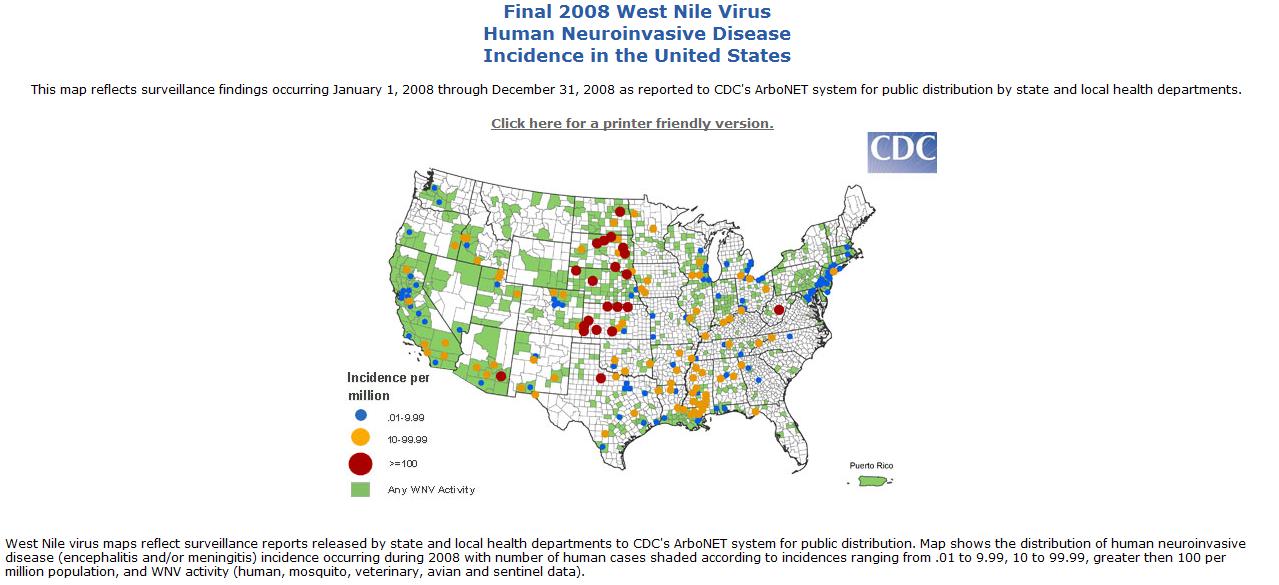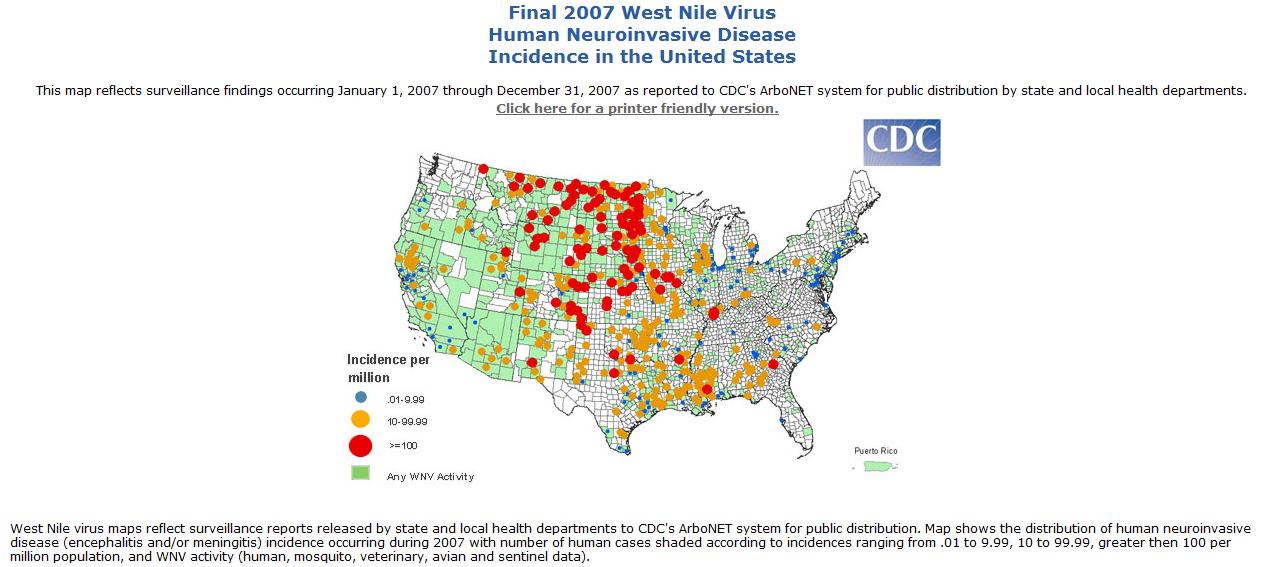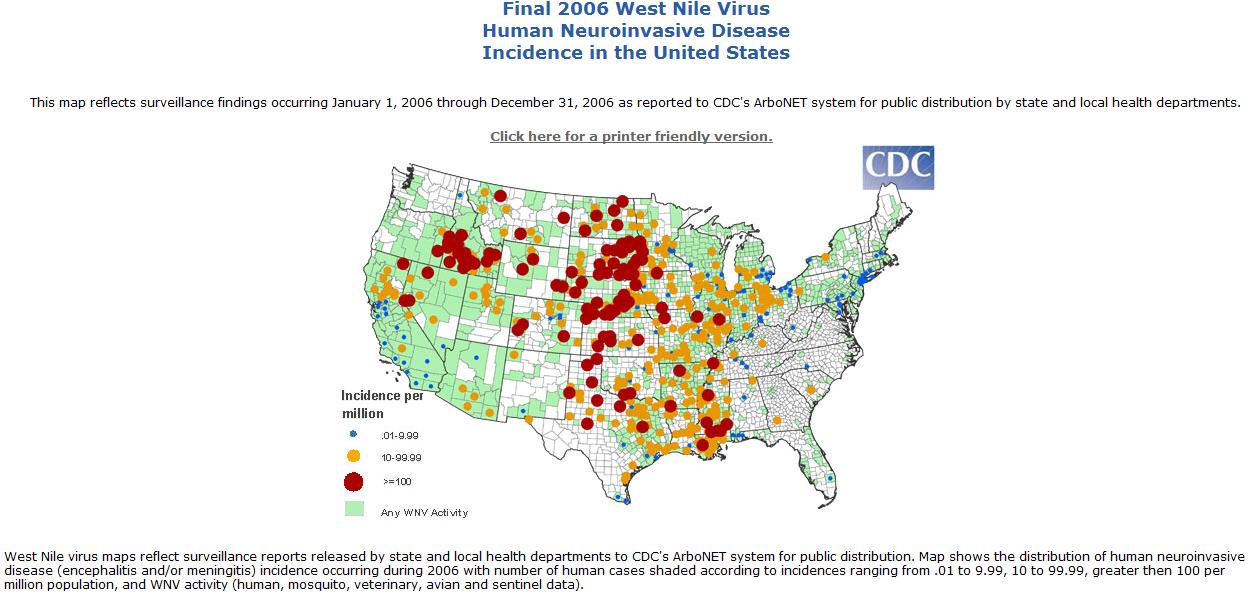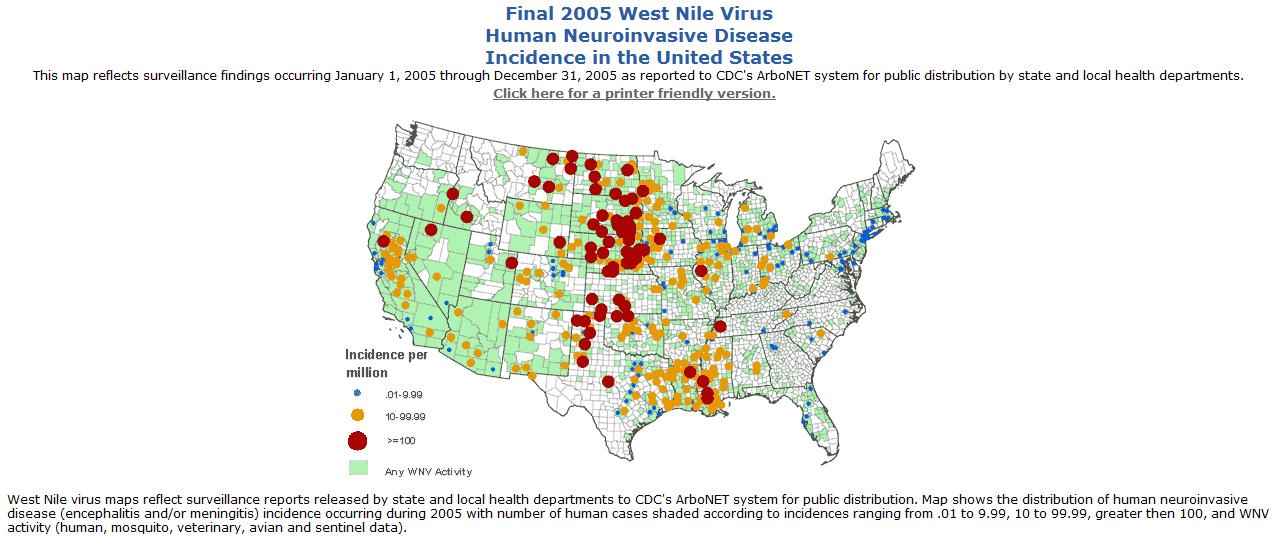West nile virus infection epidemiology and demographics
|
West nile virus infection Microchapters |
|
Differentiating West nile virus infection from other Diseases |
|---|
|
Diagnosis |
|
Treatment |
|
Case Studies |
|
West nile virus infection epidemiology and demographics On the Web |
|
American Roentgen Ray Society Images of West nile virus infection epidemiology and demographics |
|
FDA on West nile virus infection epidemiology and demographics |
|
CDC on West nile virus infection epidemiology and demographics |
|
West nile virus infection epidemiology and demographics in the news |
|
Blogs on West nile virus infection epidemiology and demographics |
|
Risk calculators and risk factors for West nile virus infection epidemiology and demographics |
Editor-In-Chief: C. Michael Gibson, M.S., M.D. [1]; Associate Editor(s)-in-Chief: João André Alves Silva, M.D. [2]; Michael Maddaleni, B.S.
Overview
WNV is considered a worldwide infective agent. Since most cases are asymptomatic and self-limited, the true incidence and prevalence of West Nile virus fever are often underestimated. Between the years 1999 and 2013, a total of 39557 cases were reported by the CDC in USA alone. The 2002 outbreak in USA marks the WNV outbreak with the most recorded rates of neuroinvasive disease. Nonetheless, only 1/140 to 1/256 cases of West Nile fever are complicated by encephalitis or meningitis. WNV infection occurs predominantly during the end of summer and beginning of fall. Females are more likely to develop WNV infection. The prevalence of the disease is not affected by ethnicity or age, but elderly patients are more likely to experience a complicated clinical course.
Incidence and Prevalence
WNV is widely distributed across Australia, Middle East, Western Russia, Southwestern Asia, Africa and Southern Europe. A series of outbreaks in the Mediterranean basin between 1950 and 1960 and in Europe and Africa between 1970 and 1980, marking a continuously waxing and waning incidence during the second half of the 20th century.[1] In America, the virus was first isolated in 1999 in New York City. The WNV disseminated rapidly across the American continent to the West coast in just 4 years and to Argentina in 6 years.[2][3] The 2002 outbreak in USA marked the highest rate of neuroinvasive disease of a single WNV outbreak. The total number of infected patients reached 4156, with 2942 (71%) of those suffering severe neuroinvasive disease.[4]
Most patients with WNV infection are asymptomatic. Accordingly, West Nile fever is considered to be underreported, either because infected patients do not seek medical attention or because they are not tested for the virus.[3] Between 1999 and 2013, a total 39557 probable and confirmed cases of West Nile fever were reported to the CDC from across the US.[5][2] The outbreak of 2012, in which 2873 cases of neuroinvasive disease were reported, occurred during a period of increased mosquito infection rate. A possible explanation for this was the severe precipitation felt during the previous winter.[6][7]
Image:WNV cumulative human disease cases.png|thumb|center|500 px|USA cumulative human disease cases of WNV in 2014. Data as of September 2014- Center for Disease Control and Prevention(CDC)[8]]]
Image:WNV Cumulative 2014 Data.png|thumb|center|500 px| WNV Cumulative 2014 Data. Data as of September 2014- Center for Disease Control and Prevention(CDC)[8]]]
Age
- The prevalence of WNV does not change with age.
- Elderly patients have a higher risk of developing severe forms of the disease.[1][9]
Gender
WNV is more prevalent in women.[1][9]
Race
The prevalence of WNV does not vary by race or ethnicity.
Season
Infection with WNV commonly occurs during warmer seasons, such as the period between late summer and beginning of fall.[5]
Geographical Distribution
WNV is considered a global virus. Outbreaks of the virus have been documented since its initial isolation in 1937 in approximately all regions of the world.
US disease sases by state - 2014
Image:West Nile Virus Disease Cases.png|thumb|center|1000 px| US West Nile Virus Disease Cases- Center for Disease Control and Prevention( CDC)[8]]]
West Nile virus by state - 2014
Image:West Nile Virus Activity by State.png|thumb|center|1000 px| US West Nile Virus Disease Cases- Center for Disease Control and Prevention (CDC)[8]]]
Neuroinvasive disease incidence by state - 2014
Image:West Nile Virus Neuroinvasive Disease Incidence by State.png|center|500px|thumb|Average annual incidence of West Nile Virus neuroinvasive disease 1999-2012- Center for Disease Control and Prevention (CDC)[8]]]
Neuroinvasive Disease Archives
References
- ↑ 1.0 1.1 1.2 May, F. J.; Davis, C. T.; Tesh, R. B.; Barrett, A. D. T. (2010). "Phylogeography of West Nile Virus: from the Cradle of Evolution in Africa to Eurasia, Australia, and the Americas". Journal of Virology. 85 (6): 2964–2974. doi:10.1128/JVI.01963-10. ISSN 0022-538X.
- ↑ 2.0 2.1 Lindsey NP, Staples JE, Lehman JA, Fischer M, Centers for Disease Control and Prevention (CDC) (2010). "Surveillance for human West Nile virus disease - United States, 1999-2008". MMWR Surveill Summ. 59 (2): 1–17. PMID 20360671.
- ↑ 3.0 3.1 Petersen LR, Hayes EB (2008). "West Nile virus in the Americas". Med Clin North Am. 92 (6): 1307–22, ix. PMID 19145778.
- ↑ O'Leary DR, Marfin AA, Montgomery SP, Kipp AM, Lehman JA, Biggerstaff BJ; et al. (2004). "The epidemic of West Nile virus in the United States, 2002". Vector Borne Zoonotic Dis. 4 (1): 61–70. doi:10.1089/153036604773083004. PMID 15018774.
- ↑ 5.0 5.1 Petersen LR, Brault AC, Nasci RS (2013). "West Nile virus: review of the literature". JAMA. 310 (3): 308–15. doi:10.1001/jama.2013.8042. PMID 23860989.
- ↑ Chung, Wendy M.; Buseman, Christen M.; Joyner, Sibeso N.; Hughes, Sonya M.; Fomby, Thomas B.; Luby, James P.; Haley, Robert W. (2013). "The 2012 West Nile Encephalitis Epidemic in Dallas, Texas". JAMA. 310 (3): 297. doi:10.1001/jama.2013.8267. ISSN 0098-7484.
- ↑ Goodman, Denise M.; Livingston, Edward H. (2012). "West Nile Virus". JAMA. 308 (10): 1052. doi:10.1001/2012.jama.11678. ISSN 0098-7484.
- ↑ 8.0 8.1 8.2 8.3 8.4 "Center for Disease Control and Prevention (CDC)".
- ↑ 9.0 9.1 Zou S, Foster GA, Dodd RY, Petersen LR, Stramer SL (2010). "West Nile fever characteristics among viremic persons identified through blood donor screening". J Infect Dis. 202 (9): 1354–61. doi:10.1086/656602. PMID 20874087.




